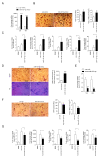7-Ketocholesterol-Induced Micro-RNA-107-5p Increases Number and Activity of Osteoclasts by Targeting MKP1
- PMID: 35409056
- PMCID: PMC8998300
- DOI: 10.3390/ijms23073697
7-Ketocholesterol-Induced Micro-RNA-107-5p Increases Number and Activity of Osteoclasts by Targeting MKP1
Abstract
Osteoclasts (OCs), which are responsible for bone resorption, play a critical role in cholesterol-induced bone loss and recent studies have suggested that various micro-RNAs (miRs) contribute to modulating OCs. We hypothesized that 7-ketocholesterol (7-KC), a metabolite responsible for cholesterol-induced bone loss, induces miR-107-5p, which affects OCs. Overexpression and knock-down of miR-107-5p were performed using miR-107-5p mimic and anti-miR-107-5p, respectively. The effects of miR-107-5p on OCs were analyzed by tartrate-resistant alkaline phosphatase staining, qPCR, and Western blot. MiR-107-5p was upregulated after 7-KC exposure in receptor activator of nuclear factor kappa-Β ligand-stimulated OCs. Furthermore, miR-107-5p upregulation was also observed in tibiae from an atherogenic diet-fed mice compared with mice fed with a normal diet. MiR-107-5p overexpression enhanced the area and number of OCs, whereas inhibiting the endogenous expression of miR-107-5p generated by 7-KC had the opposite effect. Among the possible candidates, mitogen-activated protein kinase phosphatase-1, a stress-responsive dual-specificity phosphatase that inactivates mitogen-activated protein kinase (MKP1), has been proven to be a target gene of miR-107-5p, as demonstrated by the direct interaction between miR-107-5p and the 3'-untranslated region of MKP1. Collectively, our findings demonstrate that 7-KC-induced miR-107-5p promotes differentiation and function of OCs by downregulating MKP1.
Keywords: 7-ketocholesterol; micro-RNA-107-5p; mitogen-activated protein kinase phosphatase 1; osteoclast.
Conflict of interest statement
The authors state that they have no conflict of interest. The funders had no role in the design of the study, analysis or interpretation of data, writing of the manuscript, or decision to publish the results.
Figures




Similar articles
-
The miR-155-5p inhibits osteoclast differentiation through targeting CXCR2 in orthodontic root resorption.J Periodontal Res. 2021 Aug;56(4):761-773. doi: 10.1111/jre.12875. Epub 2021 Mar 24. J Periodontal Res. 2021. PMID: 33760254
-
Osteoclast signaling-targeting miR-146a-3p and miR-155-5p are downregulated in Paget's disease of bone.Biochim Biophys Acta Mol Basis Dis. 2020 Oct 1;1866(10):165852. doi: 10.1016/j.bbadis.2020.165852. Epub 2020 May 30. Biochim Biophys Acta Mol Basis Dis. 2020. PMID: 32485219
-
miR-145-5p Increases Osteoclast Numbers In Vitro and Aggravates Bone Erosion in Collagen-Induced Arthritis by Targeting Osteoprotegerin.Med Sci Monit. 2018 Jul 30;24:5292-5300. doi: 10.12659/MSM.908219. Med Sci Monit. 2018. PMID: 30059491 Free PMC article.
-
7-ketocholesterol enhances autophagy via the ROS-TFEB signaling pathway in osteoclasts.J Nutr Biochem. 2021 Oct;96:108783. doi: 10.1016/j.jnutbio.2021.108783. Epub 2021 May 21. J Nutr Biochem. 2021. PMID: 34023424
-
Regulation of the MIR155 host gene in physiological and pathological processes.Gene. 2013 Dec 10;532(1):1-12. doi: 10.1016/j.gene.2012.12.009. Epub 2012 Dec 14. Gene. 2013. PMID: 23246696 Review.
Cited by
-
Maqui Berry and Ginseng Extracts Reduce Cigarette Smoke-Induced Cell Injury in a 3D Bone Co-Culture Model.Antioxidants (Basel). 2022 Dec 14;11(12):2460. doi: 10.3390/antiox11122460. Antioxidants (Basel). 2022. PMID: 36552669 Free PMC article.
-
7-Ketocholesterol Induces Oxiapoptophagy and Inhibits Osteogenic Differentiation in MC3T3-E1 Cells.Cells. 2022 Sep 15;11(18):2882. doi: 10.3390/cells11182882. Cells. 2022. PMID: 36139457 Free PMC article.
References
MeSH terms
Substances
Grants and funding
LinkOut - more resources
Full Text Sources
Miscellaneous

